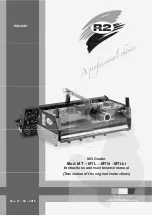
6
Figure 2: Incorrect Connections
A
Never connect two active components (snap hooks or carabiners) to each other.
B
Never connect two active components (snap hooks or carabiners) to a single D-ring
at the same time.
C
Never connect in a way that would produce a condition of loading on the gate.
D
Never attach to a object in a manner whereby the gate (of the snap hook or carabiner) would be
prevented from fully closing and locking. Always guard against false connections by visually
inspecting for closure and lock.
E
Never attach explicitly to a constituent subcomponent (webbing, cable or rope) unless specifically
provided for by the manufacturer’s instructions for both subcomponents (snap hook or carabiner
and webbing, cable or rope).
F
Never attach in a manner where an element of the connector (gate or release lever) may become
caught on the anchor thereby producing additional risk of false engagement.
G
Never attach a spreader snap hook to two side/positioning D-rings in a manner whereby the
D-rings will engage the gates; the gates on a spreader must always be facing away from the
D-rings during work positioning.
4.3 Compatibility Of Components:
Equipment is designed for use with approved components and subsystems only. Substitutions or
replacements made with non-approved components or subsystems may jeopardize compatibility of
equipment and may affect the safety and reliability of the complete system.
4.4 Making Connections:
Only use self-locking connectors with this equipment. Only use connectors that are suitable to each
application. Ensure all connections are compatible in size, shape, and strength. Do not use equipment
that is not compatible. Visually ensure all connectors are fully closed and locked. Connectors are
designed to be used only as specified in each product’s user’s instructions.
4.5 Personal Fall Arrest System:
A PFAS is an assembly of components and subsystems used to arrest a person during a fall event. A
PFAS is typically composed of an anchorage and a FBH, with an energy absorbing connecting device,
i.e., an SAL, an SRD, or a Fall Arrester Connecting Subsystem (FACSS), connected to the dorsal D-ring
of the FBH. PFAS components used in conjunction with this SRD should comply with ANSI Z359
requirements and applicable OSHA regulations.
4.5.1 Personal Fall Arrest System Anchorage Strength:
An anchorage selected for PFAS application must have the strength to sustain a static load applied in
the direction permitted by the PFAS of at least:
a.
Two times the maximum arrest force permitted when certification exists, or
b.
5,000 lbs. (22.2 kN) in the absence of certification.
Table 1B provides test data on typical performance attributes of the three principal parameters (see





































